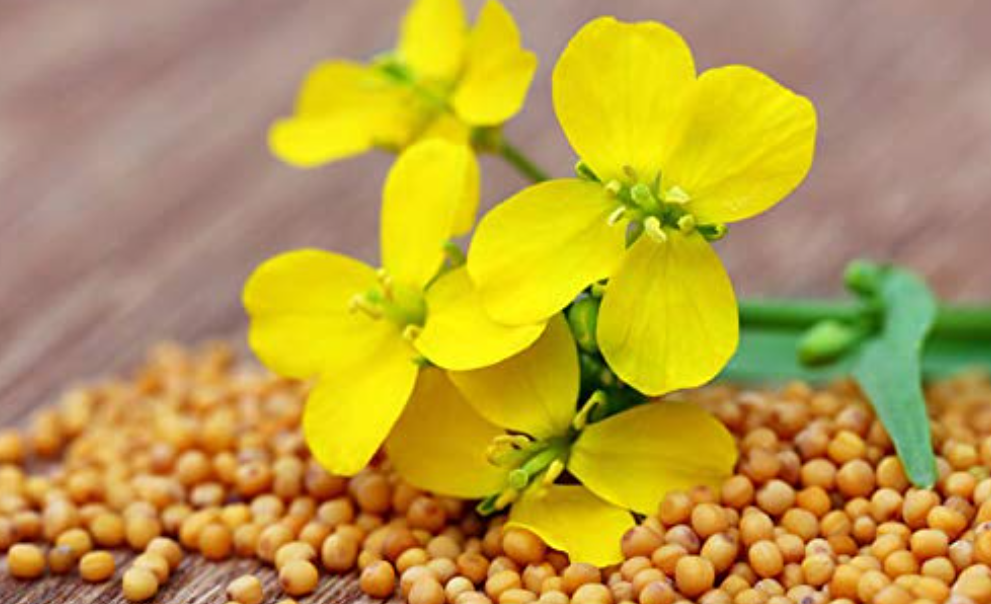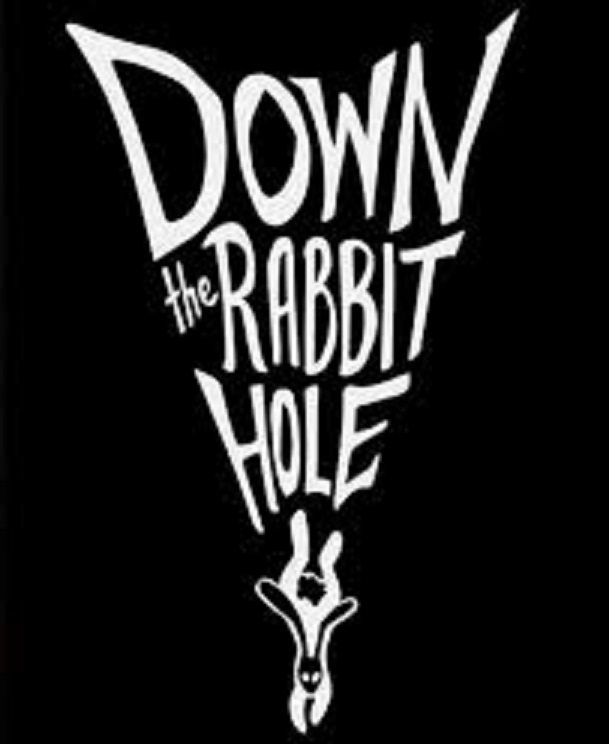
grandpa ray’s tidbits
Food for thought in 2025
We are proud to give you access to Grandpa Ray’s tidbits. Each week, something new and interesting is posted for your enjoyment.

BREAD
THE FOREVER FOOD
As I went about researching this topic, about life’s most basic food, I discovered that there was no consensus as to when mankind began its love affair with bread. My personal opinion is that mankind began utilizing bread as soon as grains began to be harvested. Bread making is universal, since every culture in the world has its own style of bread. There are three basic types of bread: high-rising types that utilize rapid-rise yeast and are baked in pans; medium rising types, like some French breads; and flatbread types, which are, undoubtedly, the oldest type.
Something else that is culturally universal is some form of distilled alcoholic beverage, like beer. Yeast is a byproduct of the distilling process; it wasn’t long before bakers began using it. In the 19th century, Dutch bread bakers obtained yeast from their brewing counterparts—the Dutch were the first to sell yeast commercially. It spread from there.
Today, with a cornucopia of commercially available foods, bread has become an afterthought, an ancillary adornment to most modern diets. The staff of life has, in some instances, become a threat to life. Bread is the main source of carbohydrates in the western diet, and is avoided by many because of health concerns— obesity and diabetes come to mind. Then there are those that love carbs with impunity—I, yours truly, am a such a one. I especially love the “Bread of life”.
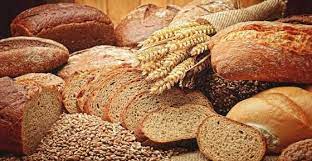
“HAPPY ST. PATRICK’S DAY FROM SENIOR SUPPER SERVICES!!!!!”
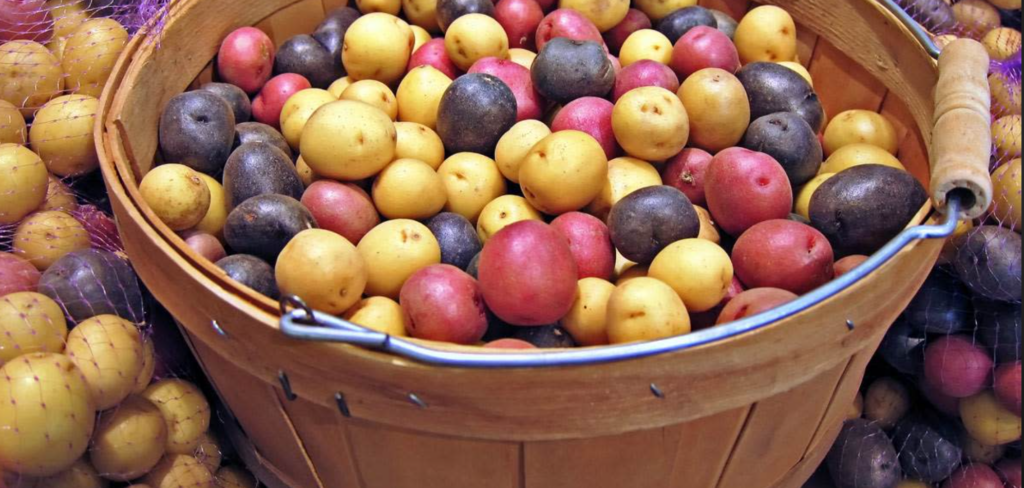
THE POTATO:
FROM UNDERGROUND TO MAINSTREAM
Even though the potato is more generally associated with the Irish because of the potato blight that triggered a famine in Ireland that killed a million people, France can claim some credit for the popularization of the allusive tuber. While people in Ireland had adapted their diets to the potato, France outlawed it in 1748. While one country depended on it to survive, the other considered it unfit for human consumption.
The person responsible for turning things around in France was a pharmacist by the name of Antwan Augustine Parmenter. While a prisoner of war in Prussia, he was forced to subsist on the lowly potato. While there (after some experimenting) he discovered that the potato could be tasty as well as healthy—I guess he didn’t have a choice in the matter. Being a man of science, he was able to refine the potato to the point of palatabilty; after his repatriation to France he embarked on a lengthy pro-potato promotional campaign. Due to his efforts, France reinstated the potato in 1772. For his contribution he has been memorialized by the culinary world—any dish prepared with potatoes is referred to as a Parmentier dish.
Edward Anton Asselbergs a Dutch Chemist took the potato to the next level in 1962 by inventing the modern process of making dehydrated mashed potato flakes— the lowly potato was set to finally take the world by storm. And it has been a “mashing” success.
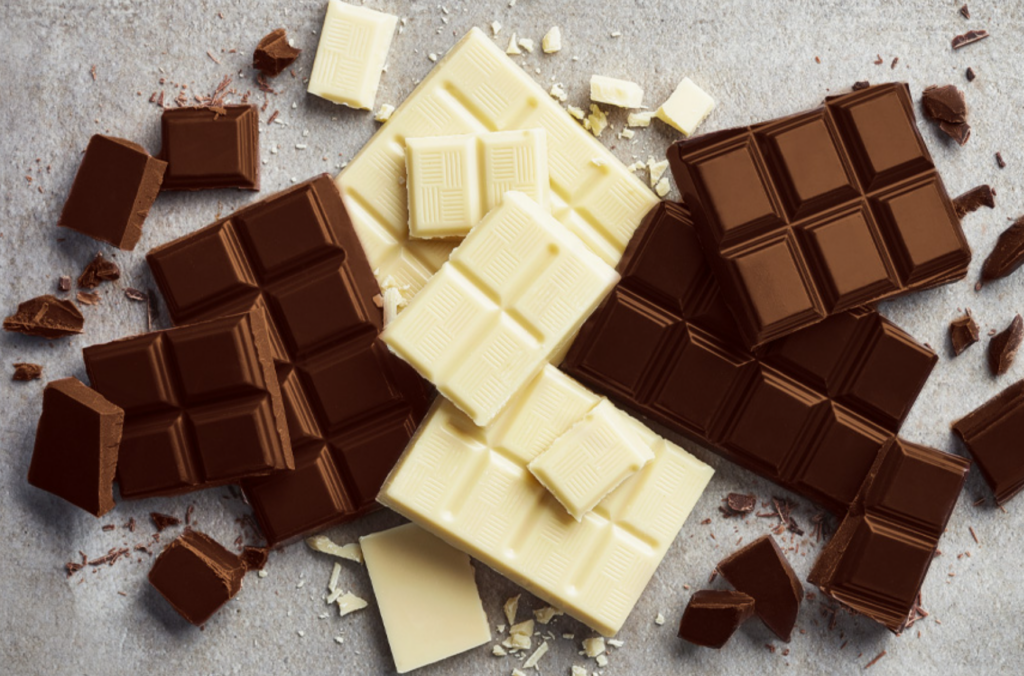
CHOCOLATE: FROM SIPPING TO BINGING
The easily available and universally loved product of the cacao bean wasn’t always the milk chocolate delicacy we know today. The ingesting of the cacao bean goes way back to Meso-America. As is typical of new found marvels, they eventually spread around the world—tea did it, coffee did it, so did cacao. For the early enthusiasts it was a lixiviate of sorts (a liquid derived from the brewing process) and undoubtedly bitter—kind of like hot coffee.
The process involved in the making of comestible cacao hasn’t changed for centuries. The naturally occurring fermentation generates heat of up to 120 degrees. This breaks down the yeast and bacteria microorganisms at the bio-chemical level, releasing the flavor compounds which give chocolate its characteristic taste. Next, the beans are dried, roasted, and ground into a paste-like substance known as “chocolate liquor”. Many different things have derived from this cacao liquor.
The next most significant advance was the powdered variation which gave us hot chocolate. Shortly thereafter, the invention of powdered milk by Swiss chemist Henry Nestle led to the next major advance in chocolate’s long evolution. This was followed by Daniel Peters who took Nestle’s powdered milk and combined it with chocolate—the result was milk chocolate. (a far cry from what your average Meso-American thought of as cacao.) The final step came from confection luminaries like; J.S. Fry, John Cadbury, and Milton Hershey who perfected milk chocolate into all the wonderful variations we have available to binge on.
FREED FROM THE KITCHEN
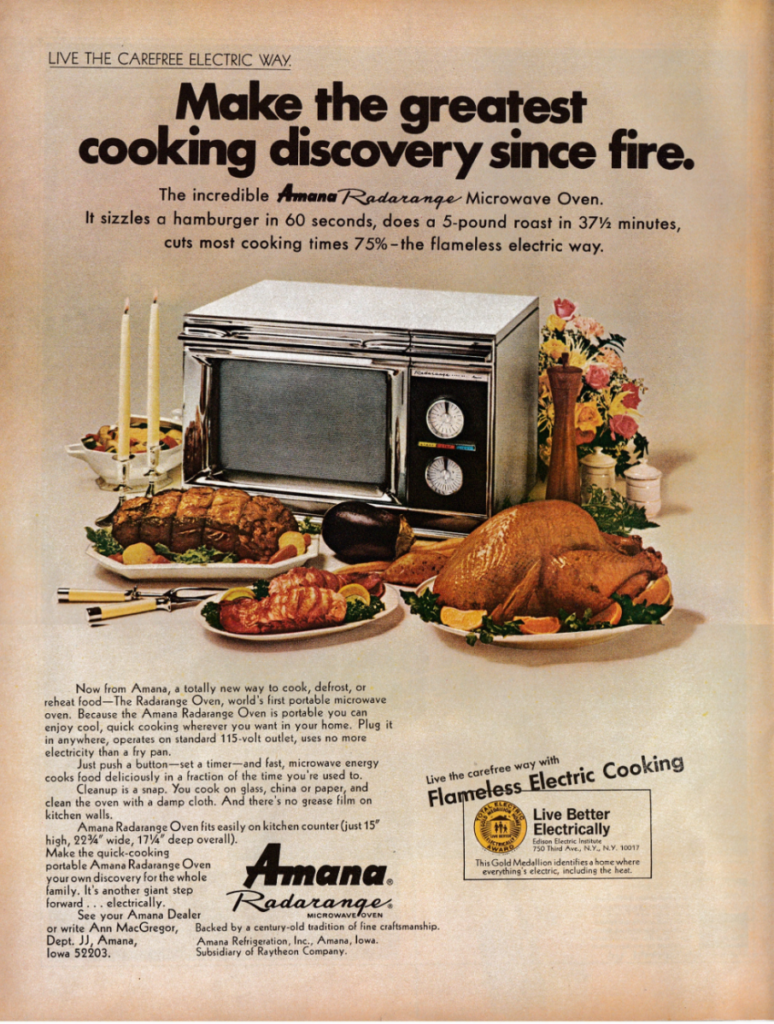
APPLIANCES AND T.V. DINNERS
—In 1900 only five percent of married women were in the work force; by 1980, 50% of all married women were in the workforce.
What factors were involved in freeing women from the kitchen and turning them into wage earners? Early prototypes of cars and refrigerators had been around for decades before the end of WWII. After the war, automobile production was paramount—America would soon be liberated by the affordable means of mobility which came to be known as the car ( a shortened form of carriage, I suppose). After the successful introduction of the automobile, industry turned its attention to home appliances— the first was the refrigerator.
The precursor to the refrigerator was the icebox; ice blocks were replaced weekly and were messy, nonetheless, now there was another alternative to food preservation. In 1927, the first fully-functional fridge came on the market; by 1984, 85% of households had one. On a different track, the most popular home appliance of all time was introduced— the television.The genius of the American mind was just getting started.
Frozen dinners were the perfect complement to the “new-fangled” fridge. First there was the frozen chicken-pot pie. Shortly thereafter, Swanson came up with heat-proof segmented metal trays, into which were put turkey dinners complete with mashed potatoes and vegetables— the TV dinner had arrived! The cascade of innovations for the home began the liberation of women from the dreaded “kitchen.”
The newly-liberated working mothers could now come home from work, heat-up some TV dinners and watch television with the family. That was just the beginning. Soon to follow were; washing machines, dishwashers, microwaves, and air conditioning. YOU GO GIRL!
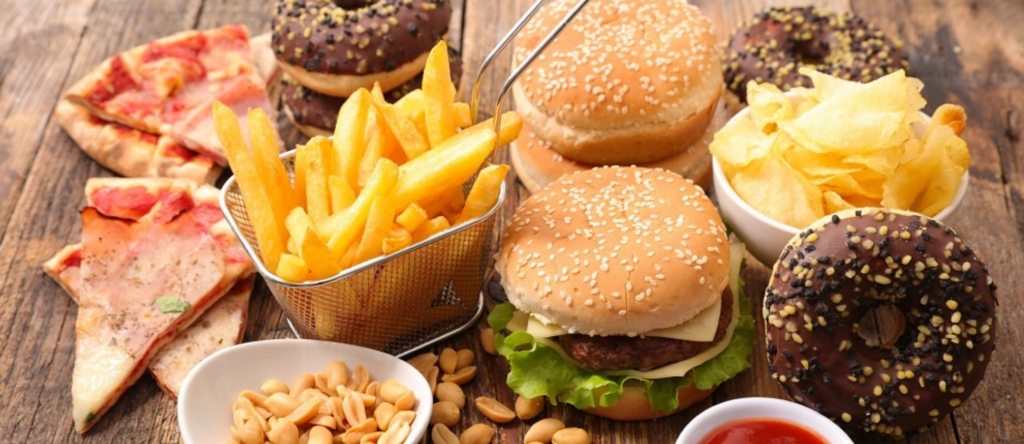
PROCESSED FOOD: IS IT REAL FOOD?
The following ten companies control 90% of all processed food manufacturing; Kraft, Coke, Pepsi, Kellogg, Mars, Unilever, Johnson and Johnson, Proctor and Gamble, and Nestle. Over the course of 50 years, these companies have been intentionally working towards a uniformity of products that have made us prisoners to a toxic food environment, scientifically engineered to addict us. Their formula for doing this has three components; mass production, engineered long shelf life, and a batch-to-batch consistency that is the same country-to-country.
How is this accomplished? Their ultimate aim is to addict you; sugar being the prime mover in this endeavor. The products they produce are food turned into commodities— a commodity is by definition a storable food with up to ten years of shelf life. Commodities can be sold in Commodity Exchanges…there no such exchanges for regular food. The transition from food to commodity denudes the food, so that it no longer is healthy to consume. The addiction aspect keeps you coming back for more, all the while, gradually destroying your health.
When fiber is removed, you can now freeze the micronutrients rendering them useless. They also add emulsifiers ( emulsifiers allow water and fat to combine) which are known to harm the intestinal lining. Then they load the result with addictive additives. The result is 74% of all products in a grocery have sugar added to them. Remember, these products are designed to be habit forming and are NOT REAL FOOD!
THE ILLUSTRATED COW
THE DEATH TATOO
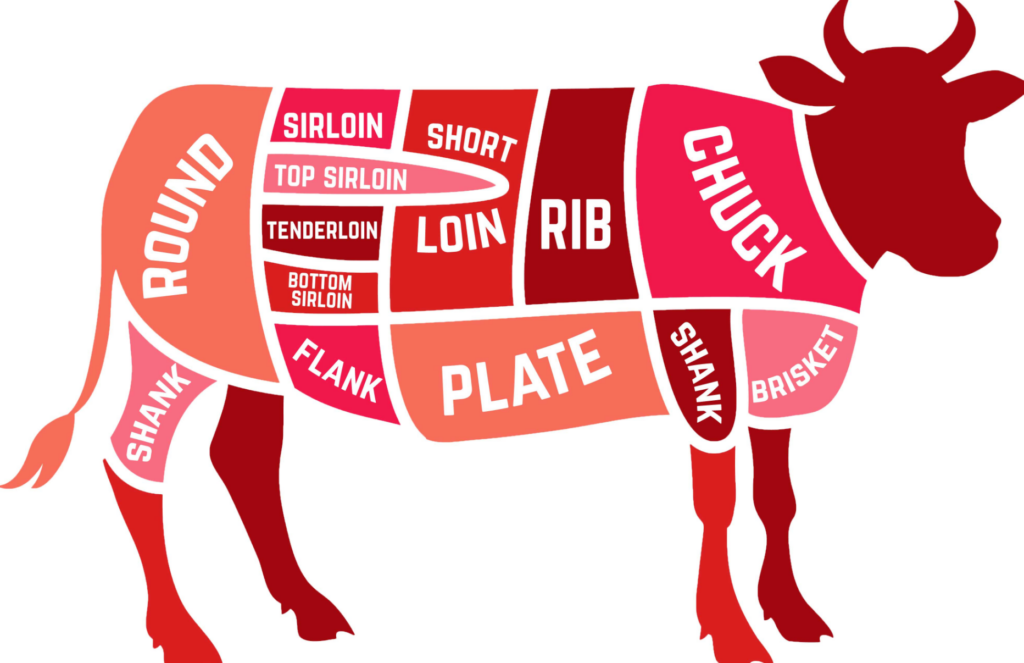
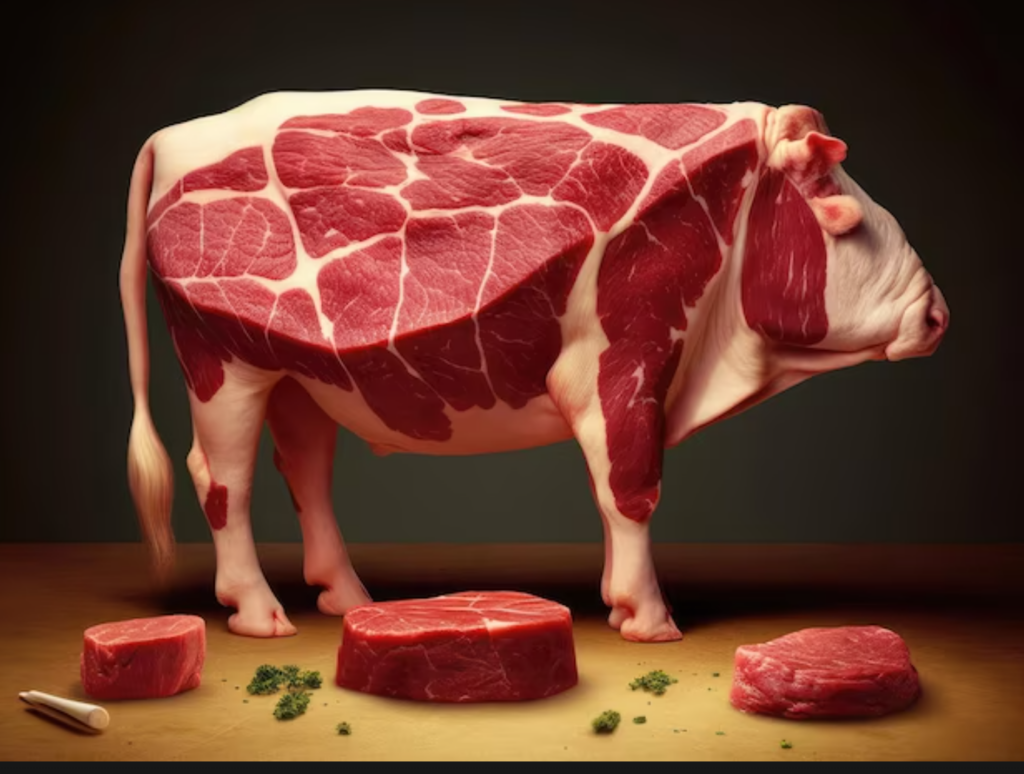

Up until recently, I labored under the mistaken assumption that when it came to steaks and cows—the whole cow could be made into steaks, or hamburger. Obviously, this is not true. When I first saw the diagram of a cow partitioned into the various butchering sections, I realized there was more to be said about the various cuts of beef; the cuts are anatomy-based. The muscle density in any section determines the toughness or tenderness of a given cut; the more muscle, the tougher the meat. That’s why the meat from weight-bearing body parts is the toughest. Hidden in the center near the top of the cow resides the tenderest of the beef…the Tenderloin. From the small end of the Tenderloin comes the “premium” cut known as the Fillet Mignon.
Three of the most popular steaks are the Rib-eye steak, the New York strip, and the Sirloin. The Ribeye is the juiciest and most tasty of the three cuts. The Strip steaks are not as juicy or flavorful as the Ribeye. The Sirloin cut is the leanest and therefore the most tender.
In addition to the above, there is still a lot of good meat to be had. You have the Ribs. There are Prime-rib, Roasts, Tri-tip, Brisket, and a variety of lesser cuts which round-out the tremendous bounty the cow affords us. I guess it can be said,
“when it comes to providing meat for us, the cow is a cut above.” Thank you very MOOOch!
FROM CUCUMBER TO PICKLE
THE DILL-ICIOUS TRANSFORMATION
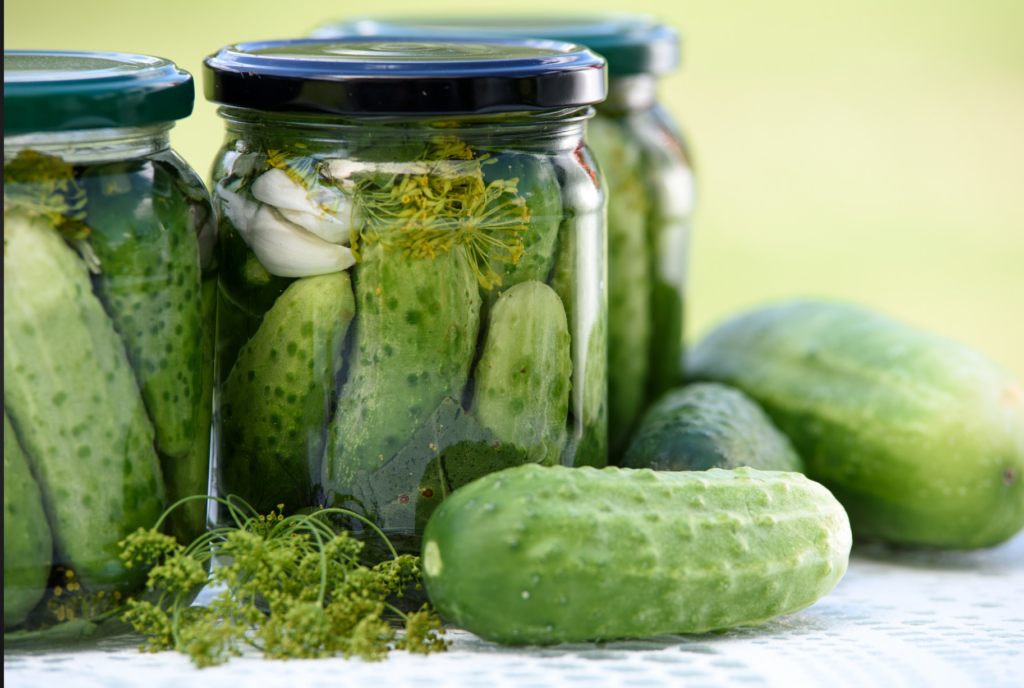
The preserving of food has been around since the advent of farming and the raising of animals—smoking and salting are used for meat and fish… brine and spices are used for various fruits and vegetables. The favorite and most popular vegetable for preserving is the cucumber, the result of which is the PICKLE. The Dutch word for pickle (Pekel) means salt; which is fitting because the brine used for pickling is nothing more than just a saline mixture mixed with dill and various other spices.
The widespread reputation of the pickle is legendary; through the ages, monarchs, kings, and prominent historical figures have declared their allegiance to it…Julius Caesar, Cleopatra, George Washington, and Peewee Herman to name a few. Basically, pickles have traversed the known universe. (but I’m quite sure they weren’t present as far back as the “Big Bang”). However, Let’s focus on the pickle’s journey to our neck of the woods—fast forward to the Golden Age of Exploration.
The “Americas” are named after Amerigo Vespucci even though he didn’t actually discover them. Thank God they didn’t use his last name…if they had, we would be known as Vespucci-land! Before he donned his “explorer’s hat”, Amerigo was a ship’s chandler. A chandler stocks ships with provisions for their voyages ; he, famously, was Christopher Columbus’ chandler. The pickled medley of vegetables he chandlered for Columbus were rich in vitamin C—they helped fend-off the scourge of “scurvy”. So, pickles by the barrel full made their way to what, thankfully, was not to become Vespuccl-land.
In America, the pickle went from barrels to Mason jars. There are now thirty plus varieties of pickles (sour, hot, sweet, kosher, etc.). The saga continues. Next, will the crunchy delight conquer the Metaverse?
Cucumbers are delicious by their own right, but their Dr. Pickle and Mr. Hyde routine has rendered them doubly so.
BACON: A SLICE OF HEAVEN—
Without question, bacon is the most popular breakfast food in Western civilization. In the USA alone, 1.7 billion pounds ( that’s 18 pounds per person) are consumed every year. Over the course of bacon’s evolution, it has taken many forms, most of which would not be recognizable as the popular rasher of today. Nonetheless, bacon from the pork’s belly is a peculiar British invention.
In England, families raised and cured pork in their basements; a practice that was eventually outlawed in 1930 because of sanitation concerns. They would fatten their pigs with acorns in the Spring and Summer, then in the Winter they would slaughter them. Each family had its own unique “secret rub”—various combinations of spices and salt. To this day, Wilkshire, England is considered the bacon capitol of the world. This is because, in 1770, John Harris introduced the first commercial production of the salty delight. In 1924, Oscar Meyer made pre-sliced and packaged bacon commercially available to the masses. People were immediately hooked, if not addicted.
Addicted? Actually, yes! People naturally crave salt, but it’s the six, flavor-bearing amino acids in bacon that act as a force multiplier in the benign addiction. Even though bacon is fashionably used in numerous creative ways—bacon mania—it has found a unique niche as the premiere breakfast food. Why breakfast? How did this come to be?
In 1925, breakfast was transformed forever; Beechnut packaging, hired Edward Bernays to head a promotional campaign that would convince people that a breakfast with bacon in the morning would replenish vital energy lost during sleep. The campaign was so successful that bacon became the dominant partner in the “bacon and eggs” breakfast we all have come to love and enjoy.
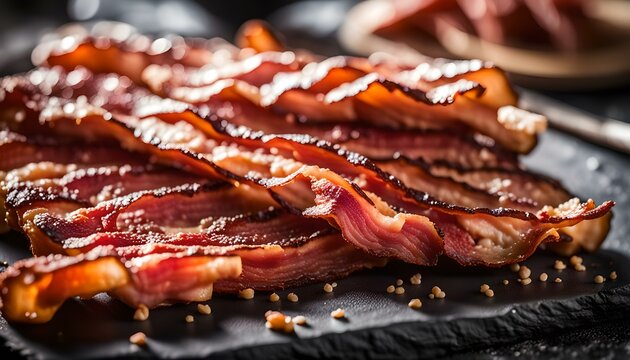
gRA
Location
Senior Supper Services
NO VISITABLE ADDRESS DELIVERY ONLY.
Redlands, CA 92404
Contact
Need additional assistance? Please contact us:
sssdelivery@yahoo.com
909-915-5765
Hours
We are open Monday to Friday, from 8:00 am to 6:00 pm.
Saturday from 11am to 6pm
Sunday: Closed
Senior Supper Services an exclusive meal Service for Seniors
WE DELIVER TO:
CALIMESA, YUCAIPA, MENTONE, REDLANDS, HIGHLAND, DEL ROSA, SAN BERNARDINO, COLTON, GRAND TERRACE, LOMA LINDA, RIALTO, BLOOMINGTON & FONTANATHE ILLUSTRATED COW

